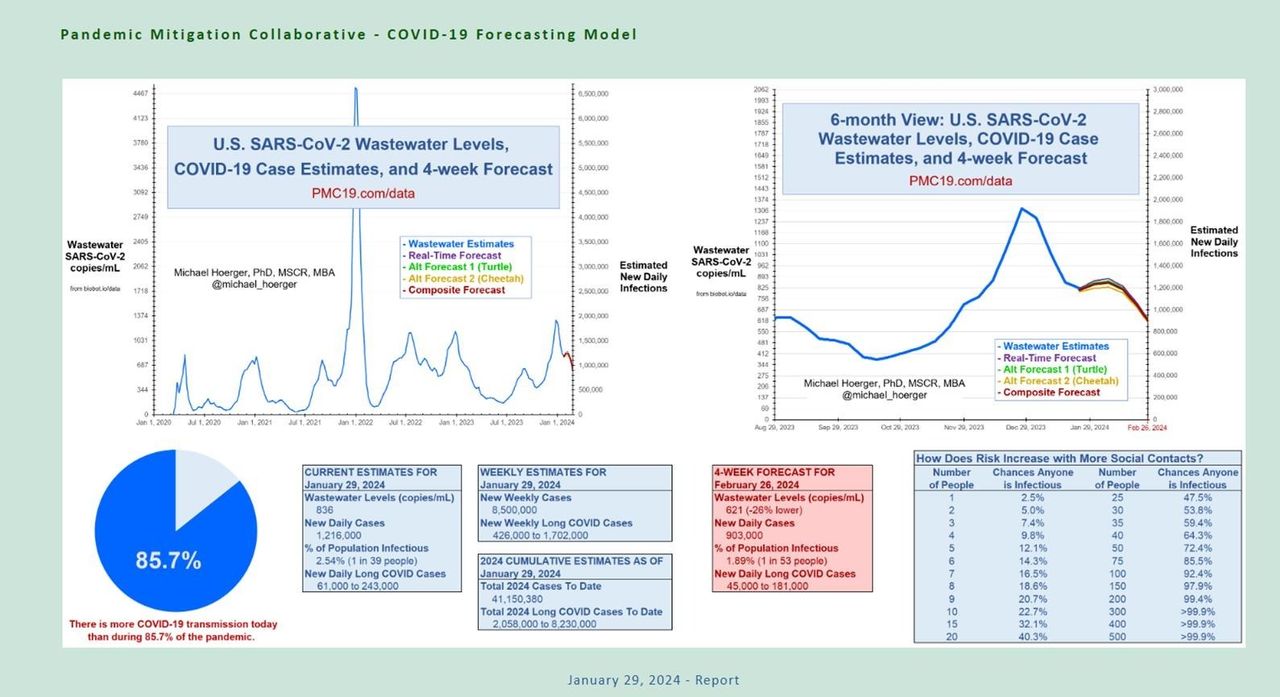
Although the current COVID-19 wave of infections with the JN.1 subvariant of Omicron peaked on the eve of the new year, the latest data on SARS-CoV-2 wastewater concentration reported by Biobot Analytics indicates rates have plateaued at around 821 copies per milliliter, which is considered a very high level. A second peak is anticipated in mid-February before infection rates begin to decline for the winter.
Modeling by clinical psychologist Dr. Mike Hoerger of Tulane University, who also teaches statistics and research methodology to medical professionals, through his Pandemic Mitigation Collaborative, estimated that this corresponds to more than 1.2 million daily infections, 8.5 million infections for the preceding week with anticipated Long COVID cases among these numbering from 426,000 to 1.7 million.
The total cumulative number of infections in 2024 is projected at approximately 41 million people. Given almost 100 million were infected by the end of December in the winter wave, it is reasonable to assume that by the end of the winter wave at least half of the country will have been infected at least once. It would also be reasonable to assume that a majority of these are reinfections. Hoerger’s estimates place the average number of infections in the US at around 3.2 times per person.
Despite these horrific figures, hardly any news media, let alone the Centers for Disease Control and Prevention (CDC) or White House, is offering any semblance of a warning to the population let alone the scale of the public health crisis that is sweeping over the population.
The infected have to go it their own relying on family or friends and neighbors, if at all, to care for themselves. All the while they will be negotiating with their employers for time off that will be deducted from their paid time off, if they have any. But even these limited measures to protect oneself and others are being curtailed by the demands of industry and not on any objectively scientific or clinical recommendations.
For example, California’s Department of Public Health, aligning their practice with “other respiratory viruses,” issued new rules in January that eliminated isolation requirements for asymptomatic COVID-positive students and most workers and limited isolation periods to 24 hours for those with mild symptoms. These regulations make a mockery of any basic idea of infection control with a virus that has a propensity to infect every organ in hosts whose immunity is limited to a brief few weeks after previous vaccination or infection and then against severe disease.
Lisa Wilson, a mother of a disabled student at Berkeley Unified High School, upon hearing of the state’s January 9 recommendations which many public-school districts across the state have readily adopted, told the local press, “The department’s recommendations have no basis in public health epidemiology … infected but asymptomatic students are still contagious. Their politically driven policies will only lead to more disability and death.”
The impact of the ending of the emergency phase of the pandemic last May is coming into view. This meant a rapid turn to abandoning all public health measures and defunding of the ability of health agencies and health systems to respond to public health threats. As a consequence, not only is COVID continuing to cause significant harm to the population, but previously checked diseases that had nearly been forgotten are once more erupting on the world stage. In particular, the emergence of measles should stand as a disturbing development and a warning that priorities need to be redirected to protecting populations.
One must ask, is California’s Department of Public Health correct to lump COVID with “other respiratory viruses” such as the flu? It would bear reviewing the clinical data between these two pathogens during the Pirola phase of COVID.
Biobot Analytics’ data also showed that wastewater concentrations for both influenza A and B peaked at the same time as SARS-CoV-2.
According to the CDC’s “Weekly US Influenza Surveillance Report,” since the flu season began in early September, there were nearly 160,000 people hospitalized for influenza infection. There were more than 460,000 COVID admissions in the same period. The peak of flu deaths occurred on the last week of 2023 with 771 deaths reported. During the same week, the CDC registered 2,250 COVID deaths, or a figure almost three times higher.
While the 2023/2024 flu-season has claimed 5,434 people, COVID-19 has killed 27,671 in the same time frame. Also, very compelling data from Greg Travis, who maintains the only excess death tracker for the United States, showed that between 2022 and 2023, around 960 children 17 years old and under died from COVID. By comparison, 248 children died in the last two flu seasons.
However, given the lifting of mandates for reporting by health systems to the CDC on COVID admissions and deaths, even these horrific figures can be construed as under-counts, underscoring the dangers posed by COVID to the elderly and infirm, who are effectively being euthanized by the inhuman policies that have prioritized finances over survival.

